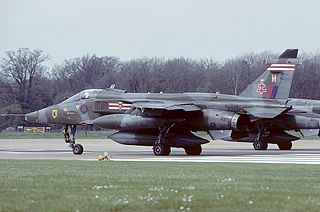
Royal Air Force Coltishall, more commonly known as RAF Coltishall, is a former Royal Air Force station located 10 miles (16 km) North-North-East of Norwich, in the English county of Norfolk, East Anglia, which operated from 1938 to 2006.

Number 23 Squadron is a squadron of the Royal Air Force responsible for 'day-to-day space operations', having been reformed in January 2021, as the first "space squadron". Up until its disbandment in October 2009, it operated the Boeing Sentry AEW1 Airborne Warning And Control System (AWACS) aircraft from RAF Waddington, Lincolnshire.

Number 6 Squadron of the Royal Air Force operates the Eurofighter Typhoon FGR.4 at RAF Lossiemouth. It was previously equipped with the SEPECAT Jaguar GR.3 in the close air support and tactical reconnaissance roles, and was posted to RAF Coltishall, Norfolk until April 2006, moving to RAF Coningsby until disbanding for the first time in its history on 31 May 2007. The squadron officially reformed as a Typhoon squadron on 6 September 2010. No. 6 Squadron is unique in having two Royal standards, having been awarded its second one by King Abdullah I of Jordan in October 1950 due to its long period of service in the Middle East.

Number 25 (Fighter) Squadron is squadron of the Royal Air Force, having reformed on 8 September 2018.

No. 41 Squadron of the Royal Air Force is the RAF's Typhoon Test and Evaluation Squadron ("TES"), based at RAF Coningsby, Lincolnshire. Its official title is "41 TES". The squadron was formed in 1916 during First World War as part of the Royal Flying Corps and served on the Western Front as a ground attack and fighter squadron. Disbanded in 1919 as part of the post-war draw down, No. 41 Squadron was re-formed as an RAF squadron in 1923 and remained on home service until 1935 when it was deployed to Aden during the Abyssinian crisis.
No. 9 Group RAF was a group of the Royal Air Force.
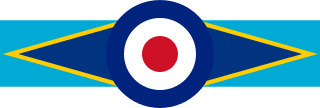
The name No. 68 Squadron has been used for two quite different units, only one of which was strictly a unit of the Royal Air Force. "No. 68 Squadron RFC" was for a time the official British military designation for No. 2 Squadron Australian Flying Corps.
The Singapore Wing, Malayan Auxiliary Air Force (MAAF) was active from its formation in June 1950, until its disbandment in 23 September 1960.
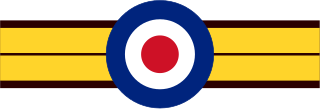
No. 264 Squadron RAF, also known as No. 264 Squadron, was a squadron of the Royal Air Force.
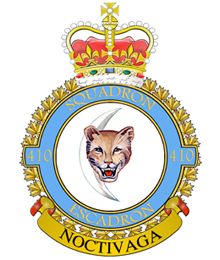
410 Tactical Fighter Operational Training Squadron, nicknamed the "Cougars", is a Royal Canadian Air Force aircraft squadron currently located at Canada's primary training base for the CF-18, at Cold Lake, Alberta. The squadron was formed during the Second World War as an RCAF squadron under the Royal Air Force (RAF), at RAF Ayr, near Prestwick, in Scotland.
No. 108 Squadron RAF was originally a squadron of the Royal Flying Corps during World War I which continued to serve with the Royal Air Force in World War II.
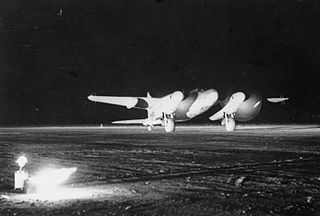
No. 256 Squadron RAF was a flying squadron of the Royal Air Force which operated during the First and Second World Wars. Initially equipped with Dh6 and Kangaroo aircraft, it operated Defiant Mk IIs, Beaufighters, and Mosquitoes in the Second World War.

No. 600 Squadron Royal Auxiliary Air Force is a squadron of the RAF Reserves. It was formed in 1925 and operated as a night fighter squadron during the Second World War with great distinction. After the war, 600 Squadron went on to operate jet fighters until 1957. Reactivated in 1999, 600 Squadron is the only RAF Reserve unit within the M25. It is a Headquarters Support Squadron and provides trained part-time reservists to support RAF operations around the world.
No. 236 Squadron RAF was a Royal Air Force aircraft squadron, which served during the First World War in the anti-submarine role, and for most of Second World War employed on anti-shipping operations.

The de Havilland Mosquito was a British light bomber that served in many roles during and after the Second World War. Mosquito-equipped squadrons performed medium bomber, reconnaissance, tactical strike, anti-submarine warfare and shipping attack and night fighter duties, both defensive and offensive. Mosquitos were widely used by the RAF Pathfinder Force, which marked targets for night-time strategic bombing. Despite an initially high loss rate due to low-level daylight attack operations, the Mosquito ended the war with the lowest losses of any of the aircraft types in RAF Bomber Command service.
No. 107 Squadron RAF was a Royal Flying Corps bomber unit formed during the First World War. It was reformed in the Royal Air Force during the Second World War and was operational during the Cold War on Thor Intermediate Range Ballistic Missiles.
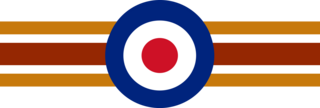
Number 125 (Newfoundland) Squadron was a Royal Air Force squadron active during World War II and briefly in the mid-1950s. Throughout its service the squadron primarily operated night fighters.
Air Vice Marshal Edward Dixon Crew, was a Royal Air Force officer and a nightfighter ace of the Second World War. He shot down 15 enemy aircraft and was one of the top-scoring aces against the V-1 flying bomb.
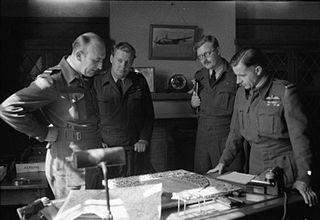
Air Vice Marshal David Francis William Atcherley, was a senior Royal Air Force officer.
No. 19 Group was a group of the Royal Air Force, active from 1918, and then from 1941-1969.













